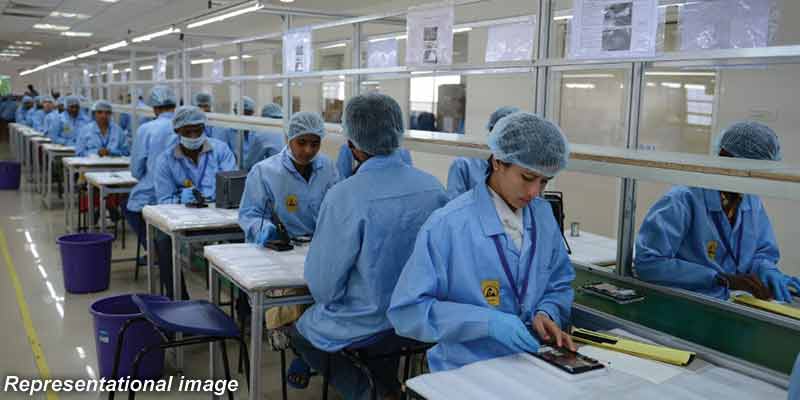- India
- Jul 31
India needs to generate 78.5 lakh jobs in non-farm sector annually
• The Indian economy needs to generate an average of nearly 78.5 lakh jobs annually until 2030 in the non-farm sector to cater to the rising workforce, according to the Economic Survey for 2023-24.
• More than jobs, the Survey added, economic growth is about generating livelihoods. Governments at all levels and the private sector will have to strive together for it.
• It said that the share of agriculture in the workforce will gradually decline from 45.8 per cent in 2023 to 25 per cent in 2047.
• To meet the demand of 78.5 lakh jobs in non-farm sector per year, there is scope to supplement the existing schemes of PLI (60 lakh employment generation over 5 years), MITRA Textile scheme (20 lakh employment generation), Pradhan Mantri Mudra Yojana, etc, while boosting their implementation.
Current employment scenario
• Over the past decade, India has witnessed a notable transformation in its employment landscape, marked by several positive trends contributing to economic growth and social development.
• According to the annual Periodic Labour Force Survey (PLFS) by the National Statistical Organisation, Ministry of Statistics and Programme Implementation (MoSPI), the all-India annual unemployment rate (persons aged 15 years and above, as per usual status) has been witnessing a declining trend since the COVID-19 pandemic.
• This has been accompanied by a rise in the labour force participation rate (LFPR) and worker-to-population ratio (WPR).
• Even by the relatively strict standards of current weekly status (CWS), employment has recovered from the pandemic in urban and rural areas.
• India’s workforce is estimated to be nearly 56.5 crore in 2022-23 using WPR from PLFS and health ministry’s population projections.
• According to PLFS, more than 45 per cent of the workforce is employed in agriculture, 11.4 per cent in manufacturing, 28.9 per cent in services, and 13 per cent is in construction.
• In terms of employment status of workers, 57.3 per cent of the total workforce is self-employed, and 18.3 per cent is working as unpaid workers in household enterprises.
• Casual labour comprises 21.8 per cent of the total workforce and regular wage/salaried workers are 20.9 per cent of the total workforce.
• Gender-wise, it is the female workforce, which is shifting to self-employment, while the male workforce’s share has been stable.
• According to PLFS, youth (age 15-29 years) unemployment rate has declined from 17.8 per cent in 2017-18 to 10 per cent in 2022-23, while other indicators have also improved over time. The rise in youth employment is also reflected in the formal employment figures, as per Employees’ Provident Fund Organisation (EPFO) data.
• From the gender perspective, the female labour force participation rate (FLFPR) has been rising for six years. While urban FLFPR has also been growing, the rural FLFPR has witnessed a steep rise of 16.9 percentage points between 2017-18 and 2022-23, indicating a rising contribution of women to rural production.
• State-wise, the top six states in terms of the number of factories, were also the greatest factory employment creators. More than 40 per cent of factory employment was in Tamil Nadu, Gujarat, and Maharashtra.
• In terms of the sectoral share of factory employment (total persons engaged), the food products industry (11.1 per cent) remained the largest employer, followed by textiles, primary metals, wearing apparel and motor vehicles, trailers, and semi-trailers.
• However, in terms of growth in employment in the last five years, the rising heft of computers and electronics, rubber and plastic products, and chemicals indicates that Indian manufacturing is moving up the value chain and have emerged as sunrise sectors for manufacturing employment generation.
Govt initiatives to boost employment generation
• “Labour” as a subject is in the Concurrent List of the Constitution of India and under the Codes, the power to make Rules has been entrusted to central government, appropriate government and state governments.
• The government has implemented a series of measures to boost employment generation, such as the rollout of the Production Linked Incentive (PLI) scheme to enhance India’s manufacturing capabilities, increase in capital expenditure, etc, and to promote worker welfare.
• This has been accompanied by a boost to self-employment through easing of access to credit, and multiple process reforms.
• Besides active interventions for social protection of workers, the government has also promoted simplification of labour laws. The government rationalised and amalgamated 29 central laws into four Labour Codes in 2019 and 2020.
• The four Labour Codes namely, the Code on Wages, 2019, the Industrial Relations Code, 2020, the Code on Social Security, 2020 and the Occupational Safety, Health and Working Conditions Code, 2020 have been enacted.
• The Code on Wages, 2019 was notified in August 2019 and the remaining three Codes were notified in September 2020.
Evolving landscape of jobs in India
• The world is in the midst of a fourth industrial revolution characterised by novel ways in which technology is becoming embedded within societies through ‘cyber-physical systems’, Internet of Things (IoT), big data, nano-technology, and networks.
• Evolving forms of machine learning, AI, blockchains, genetic engineering, quantum computing, advanced analytics, automation, and advanced manufacturing technology are some examples of what constitutes this technological revolution.
• In the backdrop of this evolving revolution, the future of job markets in India is undergoing a significant transformation, as is happening in the rest of the world.
• According to the World Economic Forum (WEF), the fastest-growing jobs in the next five years will be those of AI and machine learning specialists, sustainability specialists, business intelligence analysts and information security specialists; the largest absolute growth is expected in education, agriculture, and digital commerce.
Disruptions due to the adoption of AI
• The biggest disruption for the future of work is the accelerated growth in AI, which is poised to revolutionise the global economy. India would not remain immune to this transformation.
• AI is being recognised as a general-purpose technology, like electricity and the internet, which is phenomenal in its rapid pace of innovation and ease of diffusion.
• As AI systems continue to get smarter and adoption increases, the future of work will be reshaped. While AI has considerable potential for boosting productivity, it also has the potential to disrupt employment in certain sectors.
• Routine tasks, including customer service, will likely witness a high degree of automation; creative sectors will see extensive usage of AI tools for image and video creation; personalised AI tutors can reshape education and sectors like healthcare can witness accelerated drug discovery.
• India, with its vast demographic dividend and a very young population, is uniquely situated as AI poses both risk and opportunity.
• Widespread adoption of AI across the services sector can significantly reshape and even replace jobs.
• A particular risk is the BPO sector, where GenAI is revolutionising the performance of routine cognitive tasks through chatbots, and employment in the sector is estimated to decline considerably in the next ten years.
• A budget of Rs 10,300 crore has been provided in 2024 for the India AI Mission, a significant move to strengthen the AI ecosystem.
• Given the affinity of India’s population to work with technology, as seen with the digital public infrastructure, proactive interventions by the government and industry can position India as a key player in the AI age.
• Employees or job seekers would need skills beyond communication, collaboration, and presentation, such as analytical thinking and innovation; complex problem solving, critical thinking; learning and self-development; technology design and programming; and resilience and adaptability, to face the AI challenge.
Shift towards gig economy
• A marked shift in the employment scenario has led to the rise of the gig economy globally. It encompasses freelancers, online platform workers, self-employed, on-call workers, and creative tech talent.
• In India, the rise of the gig economy is driven by the emergence of tech-enabled platforms, an increase in access to the internet backed by the development of digital public infrastructure, the demand for flexible work arrangements, and the focus on skills.
• According to NITI Aayog’s indicative estimates based on national labour force survey data, in 2020–21, as many as 77 lakh workers were engaged in the gig economy. They constituted 2.6 per cent of the non-agricultural workforce or 1.5 per cent of the total workforce in India.
• The gig workforce is expected to expand to 2.35 crore by 2029-30. Gig workers are expected to form 6.7 per cent per cent of the non-agricultural workforce or 4.1 per cent of the total livelihood in India by 2029-30.
• While the gig economy may open up employment opportunities for various sections of workers, including youth, persons with disabilities, and women, a significant issue in the Indian context and globally has been the creation of effective social security initiatives for gig and platform workers.
Flexi job market in India
• There are nearly 5.4 million formal contract staff or flexi workers in India employed through organised contract/temporary staffing companies. These staffing companies are responsible for the timely payout of salaries/wages, social security/medical insurance towards their contract staff.
• Although they work on a contract, these workers are fully protected with social security, and the average length of contract has been rising with more than 75 per cent of the contracts in 2023 for over six months. The flexi workforce has grown at a CAGR of 13.2 per cent in the decade ending 2023, and remained positive even during the COVID pandemic.
• However, as a share of the total workforce, the contract staffing workforce is about 1 per cent only, compared to 2.2 per cent in Europe and Asia Pacific. The low percentage of flexi jobs in India indicates that the corporate sector has not replaced full-time workers with flexi workers.
• As many as 80 per cent of the flexi workers are in the 21-30 age group, with an average salary of Rs 20,000-22,000 a month. Most contract/flexi jobs in India continue to happen at the lower end of the skill spectrum such as data operations, accounts, sales, back-end operations, administration and marketing.
• Nearly 60 per cent of the flexi jobs are in logistics, infrastructure/construction & energy, BFSI - banking, financial services and insurance, IT and IT Enabled Services.
The way forward
• The government is striving to nurture the foundations of employment creation by creating an ecosystem of ease of doing business, lower logistical costs, meaningful skill development, and easy credit for entrepreneurship.
• This approach may take some time to bear results, but with steadfast efforts and good intentions, it will facilitate sustainable employment creation for everyone in the country.
• Nevertheless, there remain long-existing challenges of formalising a burgeoning workforce, facilitating job creation in sectors which can absorb workers shifting from agriculture, and ensuring social security benefits for those in regular wage/salaried employment.
• The state governments can grease the wheels of hiring by businesses by easing the compliance burden and reforming laws on land, etc, to suit the priorities of development.
• The employment landscape is fast changing worldwide, and India, aspiring to be a developed nation by 2047, must partake in the massive reshaping of jobs that AI has and is likely to further spin off. The impact of automation on workers being complex and uncertain, the direction of technological change remains susceptible to forces of political economy.
• India thus needs to invest in research and steer the AI bandwagon towards shared prosperity. At the same time, something as basic and age-old as unpaid care work needs our attention too.
• In their fascination for AI and fear of erosion of competitiveness, businesses have to bear in mind their responsibility for employment generation and the consequent impact on social stability.
• The agro-processing sector lies at the overlap of India’s requirements of productive, intermediate, and large-scale job creation for rural youth and women, with rich dividends to reap from the convergence of schemes and a mission-mode unwavering focus at a national scale.
• India can utilise the range of products on offer by its different agro-climatic zones and productively engage the sizeable rural workforce, comprising women who seek remunerative part-time employment and educated youth who can be technically skilled to handle small to medium scale agro-processing units.
• There remains ample scope for shifting MGNREGS labour to more productive and less fiscally straining ventures. Low value-addition in agriculture and rising demand for diverse and local food products also provides a good opportunity for India to create more jobs in this sector.
• There are also more avenues for captive demand of agro-processed output and the sector can benefit from the synergies between the multiple existing programmes such as Mega Food Park, Skill India, Pradhan Mantri Mudra Yojana, One District One Product, etc, for labour, logistics, credit, and marketing.
• The care economy holds great importance for a young country like India, which has both demographic and gender dividends to reap. Defining care work is the first step towards acknowledging care as ‘work’. India’s care needs are slated to expand significantly in the next 25 years, as an ageing population follows the ongoing demographic transition while the population of children stays relatively sizeable.
• By 2050, the share of children is estimated to decline to 18 per cent (30 crore persons), while the proportion of elderly persons would rise to 20.8 per cent (34.7 crore persons). Thus, compared to 50.7 crore persons in 2022, the country would need to care for 64.7 crore persons in 2050.
• Recognising the disproportionate burden of care on women being consequential to the low female labour force participation rate (FLFPR) across the world, including India, the Economic Survey also lays emphasis on ensuring equal opportunity for females by decoupling gender and unpaid care work.
• The economic value of developing a care sector is two-fold — increasing female labour force participation rate (FLFPR) and promoting a promising sector for output and job creation.
• Direct public investment equivalent to 2 per cent of GDP has the potential to generate 11 million jobs, nearly 70 per cent of which will go to women.
Manorama Yearbook app is now available on Google Play Store and iOS App Store





